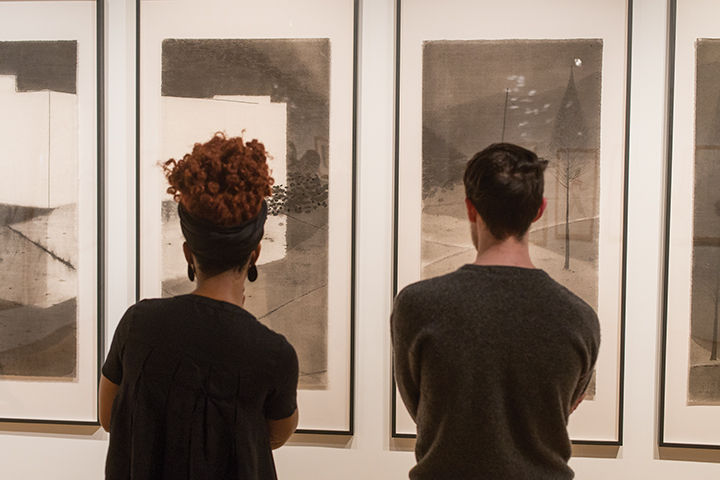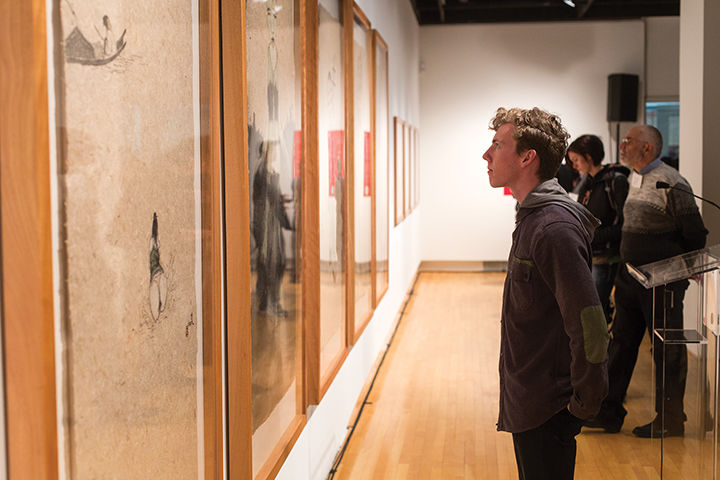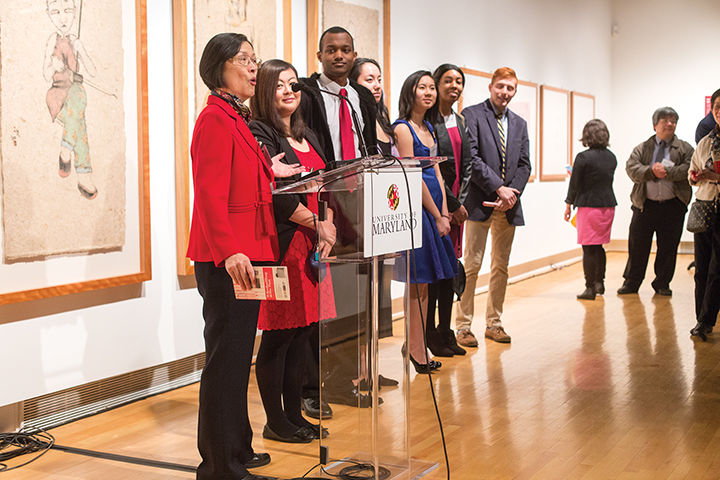After learning brush painting from her father, Jin Weihong would spend the next 30 years transforming the language of ink painting into a modern expression of emotion that crosses borders, cultures and traditions.
The Art Gallery, in partner with the Confucius Institute of Maryland, unveiled last night its new exhibition curated by Weihong, a world-renowned Chinese-ink artist. The exhibit displays contemporary Chinese ink art featuring eight of the leading explorers in ink painting in the Art-Sociology building.
The exhibition, “Reshuffling the Past: Contemporary Chinese Ink Art,” features traditional Chinese ink methods with cutting-edge and even shocking subjects and themes. It contains the work of artists Huai Yi, Jin Weihong, Li Jin, Liu Qinghe, Qian Zhongping, Shen Qin, Wu Yi and Yi Liao.
Addressing an audience of more than 200, Weihong said the artists truly want to be understood, which proves difficult in many countries where Chinese ink art is still something that is marginalized and misinterpreted.
“I’d like to take this opportunity through international exhibition to promote an understanding of this kind of art,” she said in Mandarin. “This is a signal, a gesture, so that more people understand and know this kind of art.”
Bridging cultural boundaries is possible through art, university President Wallace Loh said.
“The way that one builds bridges of understanding between cultures is not just language; it’s culture,” Loh said. “To bring a really outstanding exhibit of contemporary Chinese art to the University of Maryland as the first stop is a really big thing.”
Enjoying the beautiful Chinese Ink + Wash Contemporary Art Exhibition opening @ArtGalleryUMD. pic.twitter.com/f1SB8XeuuO
— Wallace D. Loh (@presidentloh) February 10, 2015
The Art Gallery gives students, staff and both the domestic and international public the chance to promote cultural diplomacy and community engagement, said Bonnie Thornton Dill, dean of the College of Arts and Humanities.
Although Chinese ink and wash painting is typically classical and dates back more than 1,000 years, the new exhibition focuses on presenting emerging and mid-career artists who exhibit significant and challenging art.
“These artists are not sticking to the convention; their convention is their own artistic voice. They have a different interpretation of tradition,” said Taras Matla, arts administration manager.
Donna Wiseman, dean of the education college; Zhou Hui, director of education exchanges at the Embassy of the People’s Republic of China in Washington; Curlee Holton, executive director of the Driskell Center; and Phoenix Liu, director of the Language House, also spoke at the gallery opening, addressing an audience that included College Park Mayor Andy Fellows and several international news outlets.
The Art Gallery was founded in 1955 and now displays between five and eight exhibitions each year. The gallery is funded by the Maryland State Arts Council, the National Endowment for the Arts and this university, and staff members hope to continue providing cross-cultural experiences from around the world.
“People say that young people are the future of bilateral relations, or even the world, so it’s very important for young people to get to know each other’s cultures,” Hui said. “That’s why I think events like this to be held at universities are very important, because young people get a chance to know more about other countries cultures.”
The Art Gallery is the first stop for the traveling Chinese ink art exhibition, where it will be on display until March 6. It will travel next to the Roberson Museum and Science Center in Binghamton, New York, and the Museum of Art & Design at Miami Dade College.
Though the exhibit promoted art, the understanding of culture underpinned every brush stroke, speakers said.
“When you start understanding the culture, then you start beginning to understand how people think and how they approach things, and there are differences and it’s not a matter of simply overcoming the differences,” Loh said. “But just having an understanding is the first step toward bridging those differences.”
Gavin Laughland (right) and Courtney Jackson look at the artwork at the opening of Reshuffling the Past: Contemporary Chinese Ink Art in the Art-Sociology building on Tuesday, Feb. 10.
Connor Lee, a sophomore computer science and studio art major, examines an ink painting at the opening of Reshuffling the Past: Contemporary Chinese Ink Art in the Art-Sociology building on Tuesday, Feb. 10.
Dr. Phoenix Liu, executive director of the language house, invites her students to speak at the opening of Reshuffling the Past: Contemporary Chinese Ink Art in the Art-Sociology building on Tuesday, Feb. 10.






